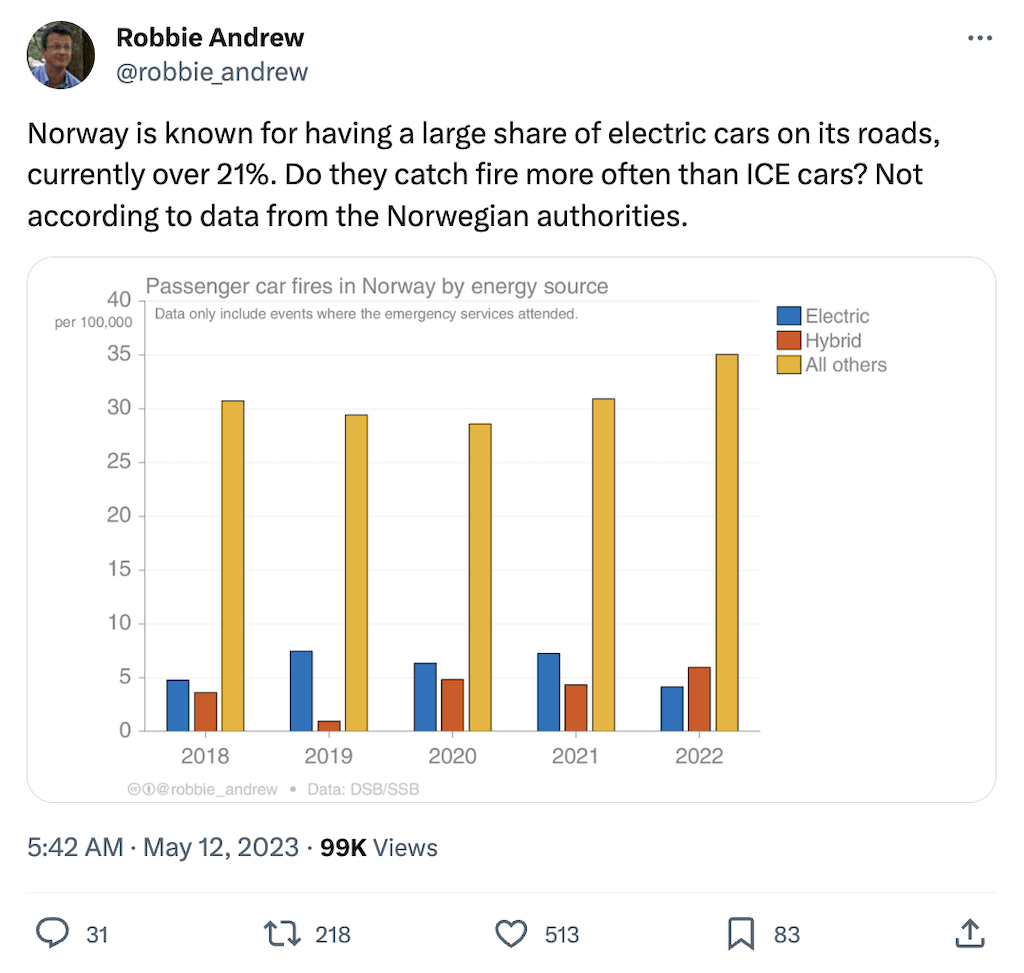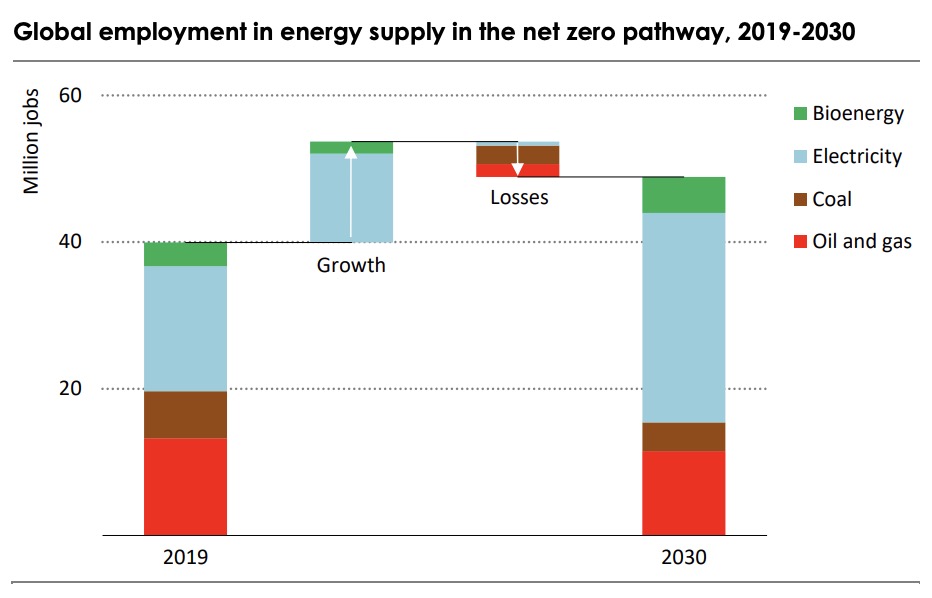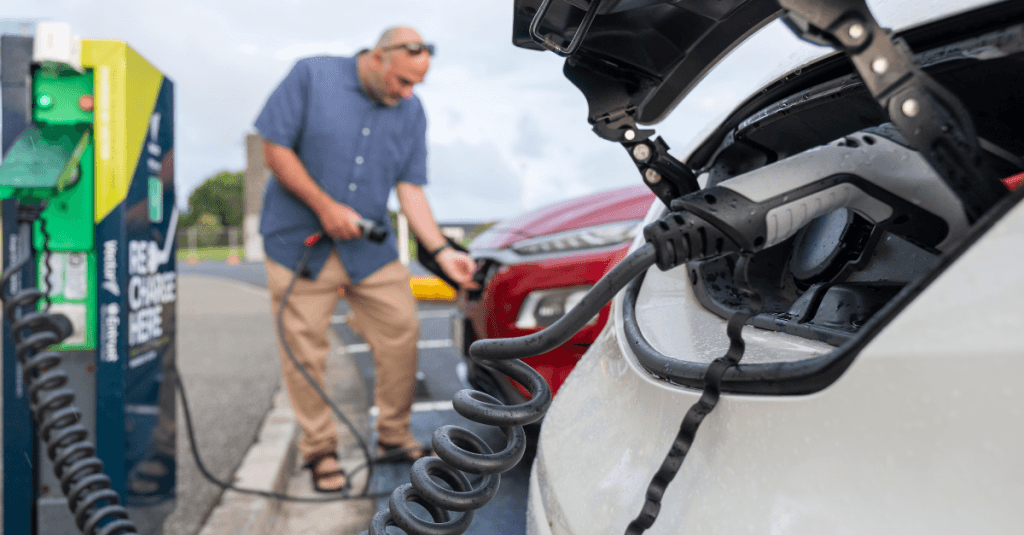Electric vehicles (EVs) have sparked plenty of conversation over the past few decades, including both truths and rumors or misinformation. From concerns about range and charging to questions about environmental impact, myths about EVs continue to circulate, despite increased testing, data, improvements, and developments within the electric vehicle industry.
EVs are no longer just a glimpse into the future but a practical, reliable, and increasingly accessible option for today. As more drivers consider making the switch, it’s important to separate outdated assumptions from today’s EV realities so drivers can make informed choices that align with their needs, budgets, and values. Below are 16 common myths about electric vehicles and the facts.
Common questions about electric vehicles can also be found in this helpful fact sheet by Argonne National Laboratory.
Table of Contents
- EVs and the environment
- 1) Myth: EVs are not better for the climate because of power plant emissions and battery manufacturing
- 2) Myth: EV batteries’ raw materials raise environmental concerns and batteries end up in landfills
- 3) Myth: Electric vehicles aren’t that much cleaner than internal combustion engine (ICE) vehicles
- EVs and operation
- 4) Myth: EV batteries are not reliable and need to be replaced often
- 5) Myth: Electric vehicles do not have enough range
- 6) Myth: Electric vehicles are not as safe as ICE vehicles and catch fire easily
- 7) Myth: EVs break down more often than ICE vehicles
- 8) Myth: Electric vehicles are slower than combustion engine vehicles
- EVs and infrastructure
- EVs and logistics
- 11) Myth: Electric vehicles are too expensive to purchase
- 12) Myth: There aren’t enough charging stations
- 13) Myth: It takes too long to charge and you will have to wait for hours on a road trip
- 14) Myth: There are not very many EV options
- 15) Myth: I won’t save money with an EV because my electric bill will go up
- 16) Myth: I’ll lose too much range in cold weather
EVs and the environment
1) Myth: EVs are not better for the climate because of power plant emissions and battery manufacturing
Fact: EVs generally produce a smaller carbon footprint than gasoline cars, even after considering the emissions from electricity used for charging and manufacturing impacts
EVs produce no tailpipe emissions, though the carbon footprint of charging depends on how the electricity generated to charge them is created. However, even so, EVs cut carbon emissions significantly, even if the electricity generated to charge them is mainly run on coal or gas, and emissions drop as more renewable energy is used.

While coal and gas are still used in many cases to generate the electricity required to charge EVs, there are many other solutions coming into play and gaining popularity, such as solar and propane. In addition, EVs are also more efficient, converting about 87–91% of battery energy into motion, compared to just 16–25% for gasoline engines.
There are some studies that show that manufacturing an EV can produce more carbon pollution than making a gasoline car. However, over the vehicle’s lifetime—including manufacturing, charging, and driving—EVs usually emit fewer total greenhouse gases because they have zero tailpipe emissions and lower operational emissions.
2) Myth: EV batteries’ raw materials raise environmental concerns and batteries end up in landfills
Fact: EV battery materials can be sourced sustainably and old batteries are not allowed in landfills
There are rightful concerns over how sustainable EVs really are when material sourcing and disposal of EV batteries is considered. However, there are ways to source materials for EV batteries sustainably and ethically, including through recycling efforts.

EV batteries can also continue to be used long after they are no longer able to power a vehicle. They can often be used for stationary storage to power things like homes and the wider electric grid. It is likely that many EV batteries still have roughly 10 years of life left in them upon removal from a vehicle.
Once an EV battery is no longer usable, it can be recycled, and it is illegal to dispose of them in landfills. Many companies that produce electric vehicles have created or are involved in creating and operating EV battery recycling programs. These programs then use the recycled battery materials to build new EV batteries.
3) Myth: Electric vehicles aren’t that much cleaner than internal combustion engine (ICE) vehicles
Fact: Electric vehicles reduce lifecycle emissions by over 55% in the US compared to combustion-engine cars, and that gap is expected to grow
As stated before, EVs may still create emissions via manufacturing and generating electricity, but it is still significantly lower than its combustion-engine counterpart. According to a recent study by BloombergNEF’s Corey Cantor, even in places where coal is still a major source of power generation, like China, EV emission reduction is still around 27%.

In the United States, EV emission reduction is roughly 57% and becomes a cleaner choice after just 25,000 miles for the average driver. Additionally, as technology advances, EV manufacturing, operating, and charging will get progressively cleaner.
EVs and operation
4) Myth: EV batteries are not reliable and need to be replaced often
Fact: EV batteries typically last the lifetime of the vehicle
Unlike starter batteries in gas cars, EV batteries are built to last the life of the vehicle and rarely fail. While EV batteries can lose some range over time, 97.5% of EVs are still running on their original batteries (excluding major recalls), with replacement rates dropping below 1% for models from 2016 onward.

Battery performance and reliability have greatly improved since 2010, with ongoing advancements aimed at boosting durability and reducing environmental impact. A study of 15,000 EVs through model year 2023 found an average battery failure rate of just 2.5% (outside of major recalls). Additionally, most of these failures were covered by manufacturer warranties, as most manufacturers offer battery warranties of at least eight years.
5) Myth: Electric vehicles do not have enough range
Fact: Daily driving needs are easily covered by EVs
In 2022, over 73% of passenger trips in the U.S. were 10 miles or less, and over 98% were under 75 miles. According to data from 2022, the average electric vehicle has a range of 211 miles, with many EVs today offering over 300 miles of range and more long-range options are on the way, making EVs easily up to the task of the average person’s daily driving needs. While driving habits and conditions, especially extreme heat or cold, can affect range, extreme temperatures also affect ICE vehicles.
If taking an EV on a long road trip, there are also resources to ensure a driver doesn’t get stranded with a dead battery, such as the US Department of Energy’s Alternative Fueling Station Locator. This interactive map allows users to filter by location and fuel, and it also has a tool to measure the distance between stations.
6) Myth: Electric vehicles are not as safe as ICE vehicles and catch fire easily
Fact: Electric vehicles are just as safe and catch fire less
Data from Norway, where over 20% of vehicles are electric, shows that gas-powered cars catch fire five to six times more often than EVs. In this study, it was shown that emergency services were called to around 30 fires per 100,000 ICE vehicles per year between 2018-2022 compared to five EV fires per 100,000 vehicles.

Another misconception is that EV fires burn more intensely or at higher temperatures than in vehicles with internal combustion engines, which is not true. The difference in ICE versus EV vehicle fires is that the risks associated with lithium-ion batteries are different from those of conventional fuels. Due to this, increasingly more emergency service employees are taking training courses on the differences in EV fires and ICE fires and how to handle EV fires.
In addition, all light-duty cars and trucks sold in the U.S.—gasoline or electric—must meet Federal Motor Vehicle Safety Standards through rigorous testing. EV battery packs also have their own safety requirements, including built-in features that automatically shut down the electrical system in the event of a crash or short circuit.
7) Myth: EVs break down more often than ICE vehicles
Fact: EVs break down less than ICE vehicles, require less maintenance, and last longer
Electric cars tend to break down less than gas vehicles because they have fewer moving parts. Between 2020-2022, EVs had an average breakdown rate of 4.2 out of 1,000 vehicles, compared to combustion cars at 10.4 per 1,000. Breakdown rates are also falling across the board. In 2020, EVs averaged 8.5 breakdowns, compared to 12.9 for gas cars. By 2022, those numbers dropped to 1.7 for EVs and 5.4 for combustion vehicles.

EVs also need less maintenance, use fewer fluids, and benefit from longer-lasting brakes because of regenerative braking. This also means that they can last just as long or longer than ICE vehicles, especially with EV battery life reaching 15-20 years.
8) Myth: Electric vehicles are slower than combustion engine vehicles
Fact: EVs are just as fast as ICE vehicles and actually accelerate faster
Top speeds in electric vehicles and combustion engine vehicles are about the same, but electric vehicles win at acceleration. The world’s fastest-accelerating production car, the all-electric Rimac Nevera, can go from 0-60 miles per hour in 1.74 seconds, but even standard EVs accelerate faster than their gas or diesel counterparts. This is due to instant torque, unlike internal combustion engines that need to rev up for peak power.
EV’s and infrastructure
9) Myth: The US power grid cannot handle an increase in EV adoption
Fact: Electric vehicles can use smart charging strategies to avoid overloading the grid, and in some cases, even help improve its reliability
While it is true that as more EVs are adopted, increased demand on the grid will occur, the impact on the grid depends on when and how vehicles are charged and how technologies like vehicle-to-grid (V2G) are used. For example, EVs can be charged during off-peak hours, like overnight, when electricity is cheaper and demand is lower.
Research shows the grid has enough capacity to support near-term EV growth, even with a mix of charging times. Also, as renewables like solar become more common, shifting more charging to daylight hours, combined with energy storage, can help manage demand.
Even if this were not true, the US electric grid currently has enough spare capacity to power nearly 200 million light-duty passenger vehicles, according to researchers at Pacific Northwest National Laboratory. In other words, up to 73% of the US passenger vehicle fleet could be electrified without needing to build any new power plants.
Additionally, EVs can actually benefit the electric grid. V2G technology allows EVs to send energy back to the grid when demand is high, and recharge when demand is low, helping to balance the system. This can also prevent blackouts or support homes during blackouts—vehicles like the Ford F-150 Lightning can now power a home for 3 to 10 days.
Another data point to note is that electricity use in the US has remained relatively stagnant for the last 20 years, despite now having nearly 5 million EVs on the road.
10) Myth: EV production is reducing the amount of available jobs
Fact: New jobs in EV production outnumber job losses in fossil fuel extraction and ICE engine vehicle production
Another common criticism of EVs is that the shift to electric transportation could disrupt the manufacturing industry and negatively impact workers. However, in 2023, the US auto industry committed over $100 billion to the EV transition, which created more than 100,000 new American jobs in the process.
Additionally, in its latest report on limiting global warming to 1.5°C, the International Energy Agency (IEA) projects that the transition to net-zero emissions could create 30 million new clean energy jobs by 2030 across sectors like low-carbon power and electric vehicles.

These new roles would outnumber job losses in fossil fuel extraction and combustion-engine vehicle production by about two to one. Within the auto industry, the IEA expects that job gains in EV and battery manufacturing would roughly offset job losses in other areas.
It is also a misconception that electric vehicles require less labor to assemble than traditional internal combustion engine vehicles, leading to less jobs. In reality, the labor needed for assembling both types of vehicles is quite similar and some studies show that EVs require more labor, at least for the time being.
EVs and logistics
11) Myth: Electric vehicles are too expensive to purchase
Fact: Total cost of ownership of an EV is often lower than an ICE vehicle
While EVs may have higher upfront costs, it has been found that their total cost of ownership (TCO) is commonly lower than that of many traditional combustion engine vehicles. This is because their overall running cost is not as high as gas or diesel cars.
EV production costs are steadily declining, and by the late 2020s, EVs are expected to reach price parity with traditional vehicles. Some manufacturers, like Tesla, also use dynamic pricing strategies, occasionally cutting the price of certain models by up to 20%, which equates to thousands of dollars.
While EVs may still have higher upfront costs, they tend to be more affordable to run, often costing significantly less than gasoline or diesel vehicles. This is in part due to the low cost of electricity compared to gasoline and less maintenance needed.
Other ways to bring down the initial cost of an EV is to buy a used EV. Most people buy used cars rather than new ones in general, and the growing availability of new EVs is now boosting the second-hand market. There are also base models of EVs available; without any incentives, a Nissan Leaf can be bought for just over $28,000.
12) Myth: There aren’t enough charging stations
Fact: There are over 75,000 stations and 207,000 EV charging ports in the US available to the public, with more being added all of the time
Today, the US has nearly as many EV charging ports as gas stations, and that number continues to grow. Public and private sectors are rapidly expanding the network, supported by $7.5 billion in funding from the Bipartisan Infrastructure Law. Additionally, National Grid and over 60 utilities have joined forces through the National Electric Highway Coalition to accelerate the buildout of fast chargers along major highways. 64% of Americans live within just two miles of a public charging station.
There are also ways to ensure you always know where a public charging station is. The Alternative Fuels Data Center has a station locator where you can filter by alternative fuel and location to find fueling locations all across the US and Canada.
13) Myth: It takes too long to charge and you will have to wait for hours on a road trip
Fact: Many of these chargers are fast chargers, some of which can charge an EV to 80% in only 15-30 minutes
Most EV drivers charge their vehicles at home or nearby, typically overnight.
Additionally, with today’s fast-charging technology (100kW), many new EVs can gain around 120 miles of range in just 20 minutes. Charging speeds have improved fivefold in recent years as engineers prioritize electric vehicles as the future of transportation. There are now almost 8,200 fast chargers across the country, or one for every 15 gas stations.
14) Myth: There are not very many EV options
Fact: There are over 100 different electric vehicle models available today and more being created all of the time
When EVs first emerged on the scene in the late 1990s, there weren’t very many options. However, over 25 years later, there are multiple makes and models available from different countries all across the world. Tools like this one from Electric For All allow you to filter by budget, manufacturer, vehicle type, electric range, and more. This EV info list also provides detailed information on many makes and models of EVs.

15) Myth: I won’t save money with an EV because my electric bill will go up
Fact: While your electric bill will go up, it still costs more to stick with a gas-powered vehicle
While it’s true that charging your EV at home will raise your electric bill, the reality is that gas is not only more expensive than electricity, it’s also far more volatile.
On average, a person drives about 14,200 miles per year with an average fuel economy of about 27 miles to the gallon. As of this article’s publication, Illinois’ current average price per gallon of regular gas is $3.44 per gallon. This equates to roughly $1,809 in gas each year.
However, an efficient EV can travel about four miles per kilowatt-hour. Depending on where an EV owner lives, at 14,200 miles per year, charging an EV at home costs anywhere between $500 and $720 per year. That’s $1,089 to $1,309 in savings per year.
16) Myth: I’ll lose too much range in cold weather
Fact: While EVs can lose around 40% of fuel economy in winter, there are multiple way to increase performance, battery life, and fuel economy
Electric vehicles do lose range in cold weather. However, ICE vehicles have their own range of problems in the winter as well that we have adapted to.
Just like ICE vehicles, there are ways to ensure your EV gets the range it needs, even in cold weather. This includes preparing an EV for winter, efficiently heating the interior, and remaining prepared. This blog we published back in February covers how to get better fuel efficiency in the winter with an EV.

Whitney began working with IACT in 2023. With a degree in English and a minor in Art, Whitney has worked as both a newspaper reporter and a digital marketing and events manager, bringing 7 years of marketing and 8 years of content creation experience to IACT. Whitney is passionate about nature and preserving the environment, including solutions to cleaner air and greater sustainability, and is a former Chicago resident.
Article is written at the discretion of the author.



